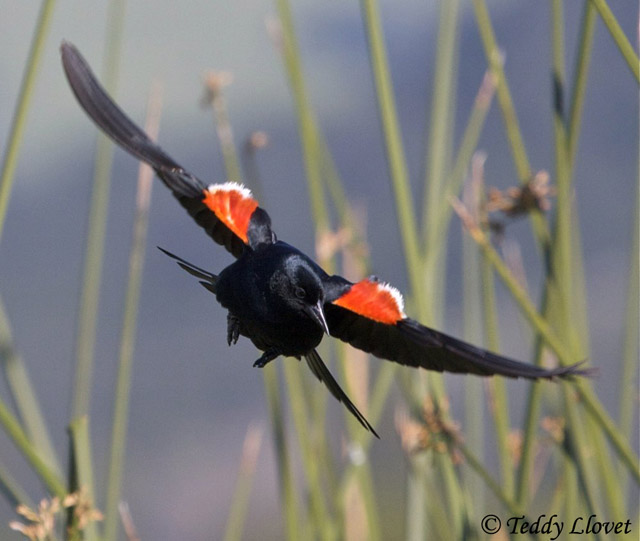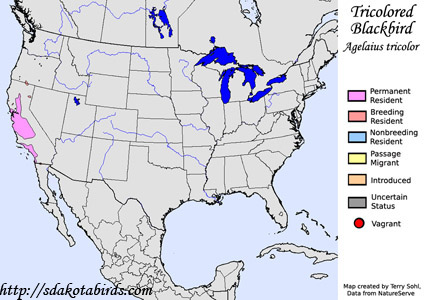| Length: 8.75 inches | Wingspan: 14 inches | Seasonality: Non-resident in South Dakota |
| ID Keys: Males black overall, dark red lesser coverts with white median coverts. Females similar to Red-winged Blackbird females, but with less warm tones. | ||
 The
Tricolored Blackbird is a close relative of the
Red-winged Blackbird, with
primary identification difference being a whitish stripe on the median
coverts of the Tricolored Blackbird compared to a yellowish stripe on a
Red-winged Blackbird. Tricolored Blackbirds have a very limited
geographic range, with most birds found nesting in the central California
Valley. Populations have sharply declined in recent decades as wetland
habitat in their breeding range has been lost. In addition, breeding
birds in agricultural areas often exhibit complete breeding failure when
agricultural fields are harvested. Other potential reasons for the
decline of the species include pesticide use and killing of birds as
agricultural pests.
The
Tricolored Blackbird is a close relative of the
Red-winged Blackbird, with
primary identification difference being a whitish stripe on the median
coverts of the Tricolored Blackbird compared to a yellowish stripe on a
Red-winged Blackbird. Tricolored Blackbirds have a very limited
geographic range, with most birds found nesting in the central California
Valley. Populations have sharply declined in recent decades as wetland
habitat in their breeding range has been lost. In addition, breeding
birds in agricultural areas often exhibit complete breeding failure when
agricultural fields are harvested. Other potential reasons for the
decline of the species include pesticide use and killing of birds as
agricultural pests.
Habitat: Found in large freshwater marshes during the summer breeding season. At other seasons, can be found in a variety of open habitats where foraging opportunities exist, such as farm fields, pastures, wetlands, and grasslands.
Diet: Feeds heavily on insects and spiders during the summer months. Also feeds heavily on seeds and waste grain, especially during the winter months.
Behavior: Most foraging is done while walking on the ground. Gregarious, usually found foraging with other Tricolored Blackbirds, or other blackbird species.
Nesting: The nest is a cup of wetland vegetation and grasses, built in vegetation at the wetland edge (often using cattails). The female lays between 3 and 5 eggs, and she alone incubates them. Upon hatching, both parents help to feed the young, who leave the nest within 2 weeks.
Song: Song of a Tricolored Blackbird is a harsh descending gurgling series of notes.
Migration: Considered a permanent resident throughout much of its range. However, some birds at the far northern edge of their range will move southward a short distance for the winter. Populations may also move short distances in response to local foraging opportunities.
Interactive eBird Map: Click here to access an interactive eBird map of Tricolored Blackbird sightings
Similar Species: Very similar to Red-winged Blackbird.
Feeders: Will occasionally attend feeders for various seeds.
Conservation Status: The IUCN lists the Tricolored Blackbird as an "Endangered" species, due to significant population declines.
Further Information: 1) California Partners in Flight - Tricolored Blackbird
2) BirdWeb.org - Tricolored Blackbird
3) Audubon - Tricolored Blackbird
Photo Information: Photo taken by Teddy Llovet - Photo licensed under Creative Commons Attribution NonCommercial 2.0 Generic License.
| Click below for a higher-resolution map |
 |
| South Dakota Status: Non-resident in South Dakota |
Additional Tricolored Blackbird Photos (coming soon!!)
